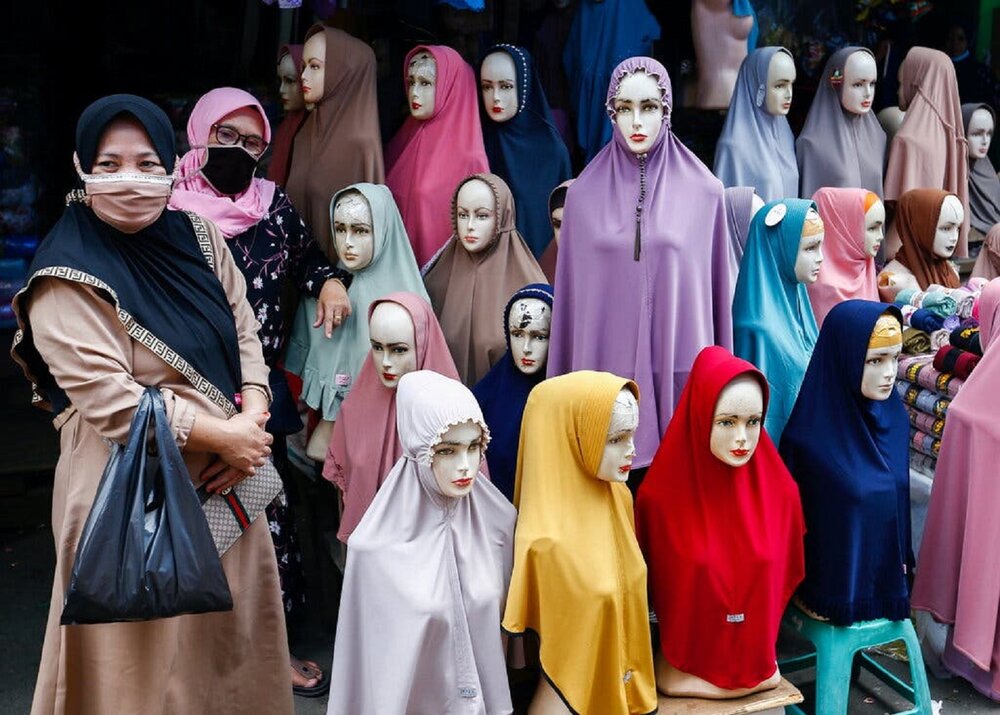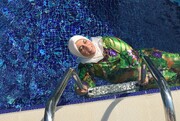Hawzah News Agency –These past two years saw most people’s lives turned upside down by Covid-19, and our lives at home and work are still undergoing one of the most radical shifts we’ve seen in generations. How we dress — and how our dress both reflects our values and affects the economy — has also begun to change, as we continue to mask up and tend toward a more protected lifestyle.
Interestingly, this metamorphosis sparked by a pandemic was always the norm for those who live an Islamic lifestyle, sometimes referred to as the “modest lifestyle.” Muslims, who have a collective spending power of about $2 trillion, are taught to embrace modesty with elegance as a form of dignified living. Now that covering for protection has become standard practice for many people, I believe it highlights the benefits that Islamic fashion has always offered, while helping to destigmatize and eliminate it as an excuse to judge those of us who wear it. I also believe this overlap will push Islamic fashion to become a bigger global player in defining style for years to come.
Muslims’ firm commitment to the modest lifestyle originates with the Quran verse in which Adam and Eve’s self-consciousness about being naked led them to cover. Islamic fashion serves a pragmatic purpose for Muslims, as it represents this “fitra,” or original state of purity. Yet Muslim attire has often come under attack. The Western world has called Muslim women weak and oppressed for covering their heads. Movements have been organized to ban the hijab, no matter the many occupations and dignified people who proudly cover their heads or faces without reproach: surgeons, nurses and bakers, who do so to protect people’s health; or even practitioners of other faiths like Jews, Catholics, Sikhs, Hindus and Buddhists. Imagine forcing Mother Teresa to remove her head scarf.
Islamic fashion, however, also has practical and science-endorsed benefits. The face veil, for example, is not widely embraced, but some of the small minority of Muslim women who wear one have said that veiling makes them feel safer and allows them to be discreet. It also filters dirt and dust, and is more protective than nothing at all in situations like using public transportation. And the fact that it’s fabric means it’s less likely to be as stifling as an N95 mask.
During the pandemic, the protective face mask became the world’s nod to the veil. Face coverings are now an ultimate gesture of courtesy toward the people around us. And after wearing masks for more than a year, some women today share the Muslim perspective of feeling safe behind a covering, especially from unwanted male attention.
Yet in France, face veils are banned. And in April, the French Senate passed an amendment that would ban girls under 18 years of age from wearing the more common hijab. Even the burkini, a versatile piece of activewear unmatched in comfort, style and protection, is considered a threat, because it’s worn primarily by Muslim women. The country never faced a backlash against similar looking wetsuits for snorkeling or diving. When it imposed a 135 euro fine on anyone not wearing a face covering during the pandemic, I saw a clear double standard, given the 150 euro fine the country gives to those wearing a face veil.
After decades of criticism, it’s peculiar to see the world embracing what to me is just another facet of Islamic fashion. I believe that shift, though, is an indicator that Islamic fashion will play a larger role in shaping style norms and economics in the years to come.
My own work in Islamic fashion and design has helped me to understand that the best form of evolution comes from a foundation built upon age-old wisdom; good ideas are rarely new. I’ve experienced how the fashion and design industries can be a great source of building relationships and dispelling false impressions.
Historically, Western cultures have largely embraced more modest forms of dress, until mass production enabled a new, high-turnover system of consumption, leading middle-class consumers to frequently change styles as a sign of “progress.” As a culture of imitating and following gave way to a lucrative cycle of profit in the fashion industry, competitive exhibitionism — spurred in part by social changes like new waves of feminism — outpaced modesty.
Though not unscathed by those changes, Islamic fashion is rooted in something more concrete: Muslims’ belief that their values remain because of God’s promise to preserve their faith until the end of time. Islamic fashion will continue to grow because it is part of a valuable journey for us, not a trend. Those who embrace it do so because of principles within a lifestyle that has been passed down to us for generations. For me, that means a lifelong commitment to this attire, which is worn by the fastest-growing population in the world.
It’s also undeniably chic and stylish. The iconic Hollywood head scarf look, made famous by contemporaries like Jennifer Lopez and dating back to Audrey Hepburn and Grace Kelly, showcases our typical hijab. That, along with an elegant full-sleeved, full-length, high-necked, high-backed, not-too-tight evening dress and similarly slick daywear, are now magnets for fashion photographers.
As we see Islamic fashion taking its place in the broader culture, it’s encouraging to see it garnering growing acceptance and appreciation, in part because of the huge potential market that brands see in Muslim customers. Islamic fashion has essentially entered the mainstream, as the fashion world strives to offer a stylish approach to covering. The increasing number of adaptations and modest collections by the mainstream brands — think of the Nike Pro Hijab or Dolce & Gabbana’s line of hijabs and abayas — also invites an understanding of who we are as Muslims and of the modest lifestyle as an asset rather than a threat.
Not all adaptations target us, although it behooves mainstream brands to learn about how Muslims’ beliefs inform their modest fashion choices. Consider Kim Kardashian’s shrouded, all-black look at the 2021 Met Gala. Some people compared the outfit to a Muslim woman’s burqa, but I fail to see how the tight, body contouring getup comes even close. Commentators overlooked a better comparison — Rihanna’s hijab and abaya-like look, which seemed like a genuine ode to Islamic fashion.
Nevertheless, the gala confirmed a key message: There is no compulsion behind the act of covering. And as enviable as it is for Muslims to see no backlash against Kardashian’s fully covered face, Rihanna’s hijab or even Kendall Jenner’s nearly naked look, when we have been subjected to so much criticism for our dress, the whole scenario is a reminder that garment choices are not an invitation for anyone’s judgment. This invites a new level of respect and a hope of not being attacked for our faith-based values.
It’s worth noting that the coveted global Muslim consumer group is not interested in designers who believe they need to liberate us. Giving us designs that bare our midriff but leave a scarf on our head will likely be seen as offensive, and leave us feeling exploited. Successful designers will understand why we value Islamic fashion so much, and they’ll know how to rock Islamic tradition — not disgrace it — with style.
Today, all forms of covering have become the courteous thing to do. Though it took a pandemic to appreciate that, I think the opportunity it presents for all people and businesses — mainstream and Muslim — is significant.



Your Comment